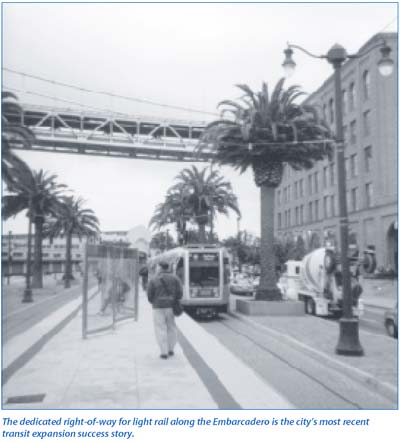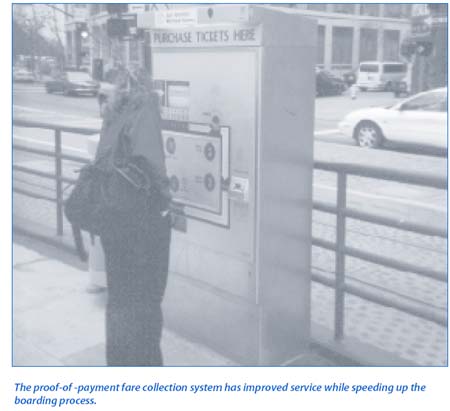
SAN FRANCISCO’S TRANSPORTATION PROBLEM
San Francisco’s transportation problem can be summed up easily: there is not enough space for everyone to use automobile-based forms of transportation at all times. While some might consider automobile congestion a problem, it is important to emphasize that this “lack of space for cars” is perhaps one of the key reasons for San Francisco’s excitement, livability and economic success. Cities that have focused on providing enough space for automobiles are nowhere near as economically vital, livable and interesting as San Francisco—and amazingly, even these cities can’t provide enough space for all the automobiles that want to use the system. To paraphrase: with roads and parking, if you build it they will congest it.
San Francisco wisely recognized that unlimited use of the automobile was not the solution to the city’s transportation problems in 1973 when it first adopted the Transit-First Policy. This policy stated that priority must be provided for transit over private automobiles. In 1999, Prop. E broadened the focus to include bicycles and pedestrians. The Transit-First Policy has never been fully implemented. Too often, it is difficult to get from place to place by any means. To truly follow the mandate of the Transit-First Policy, we have to go farther than we ever have in our support of quick, reliable and frequent transit service.
There are many ways to give priority for transit, including designating transit-only lanes, adjusting traffic signals to turn green for transit when street cars and buses approach, reconfiguring streets to make it easier for transit vehicles to move through traffic, reducing automobile interference with transit vehicles and ultimately, constructing exclusive right-of-way and/or grade-separated transit systems like BART or Muni Metro. While many of these transit-priority techniques have been partially implemented in San Francisco, they have not been adopted nearly as broadly as they must be to address the city’s growing transportation demand and are not vigorously enforced.
Congestion on the streets means that it’s more important than ever to get Muni out of the traffic. For Muni to work the way we all want it to, the answer probably must include dedicated rights-of-way.
NEEDED: A CITYWIDE PLAN FOR TRANSIT EXPANSION
San Francisco needs a city-wide network of quick, convenient and interconnected transit lines. These lines should connect easily with regional transit systems and major San Francisco destinations. They should be safe and attractive for all passengers.
There should be excellent transit connections between San Francisco and the rest of the Bay Area. While the suburbs do not have high enough densities to support urban transit frequencies, the framework already exists for connecting San Francisco to other regional centers: Oakland, San Jose, and the cities that ring the bay.
Residents and visitors should be able to use San Francisco’s public transit system to make almost all their normal trips that are not within walking distance. In those cases where public transit cannot be used, alternatives to private car use (and parking) should be available including taxis, delivery services, car-sharing, and rental cars.

Finally, San Francisco’s transit system must recognize the benefits of walking and bicycling. These modes must be fully integrated with transit, but they are also critical because in themselves they help address San Francisco’s key transportation problem, the lack of space for unlimited automobile use.
The transit expansion plan must identify both long- and short-term capital improvements to both Muni and regional transit agencies within the city. The plan must recognize reasonable funding scenarios. Very significant capital improvements to our transit system are clearly justified, but it is highly unlikely that San Francisco can find enough money right away to build all the needed projects. Therefore, we must set priorities and design improvements to be implemented over time.
In broad terms, San Francisco’s strategic plan for transit expansion should include two pieces:
1) Transit Improvement Program— A cohesive citywide plan for improving the transit system that increases its capacity, improves its performance, provides for full integration of fares on all carriers, and increases its attractiveness to all passengers; and,
2) Implementation Program—A plan for obtaining funding and building the improvements.
SPUR believes that both the transit improvement program and the implementation program must be envisioned and presented as a comprehensive plan, not on a piece-meal basis. The plan must be more than just a list of projects; it should relate the projects systematically to one another, to the whole Muni network, and to the fabric of the city. SPUR also believes that the citywide plan for transit improvement must be developed in a community-based process; therefore the thoughts presented below are simply ideas that should be considered in that process.
TRANSIT IMPROVEMENT PROGRAM
San Francisco has an extensive transit network, consisting of buses and rail transit that brings transit to within walking distance of virtually every resident. The problem is that because most transit vehicles operate in mixed traffic with frequent stops, their speed is simply too slow to attract additional riders who have a choice of modes. Traffic also interferes with reliability, and increases operating costs. In addition, the capacity of buses is severely constrained, requiring the inefficient operation of an excessive number of vehicles in heavily traveled corridors. These problems will get progressively worse as San Francisco’s streets are further overburdened as the city grows.

While buses operating on mixed flow streets will always be an essential part of San Francisco’s transit system, we believe the key need facing the city today is for an expansion of Muni’s transit-preferential network. This means increasing the number of transit- only lanes and expanding Muni’s exclusive right-of-way and gradeseparated light rail network. In some cases, this will mean simple improvements such as enforcement of “diamond lanes,” in other cases this will mean “Rapid Bus” technology similar to Curitiba Brazil or Los Angeles; and in cases with very high demand, it will mean exclusive right of way or grade-separated Muni Metro service extensions, i.e., subways.
The benefit of an expanded transit system lies not as much in the improvement of any individual line, but in the development of a network of rapid, reliable, coordinated and efficient transit lines connecting all the city’s neighborhoods to multiple destinations. Potential Muni expansion projects must be presented not as individual projects but as a cohesive plan to create an interconnected transit network.
San Francisco should also make use of the segments of regional systems that serve the city. Artificial institutional barriers between different operators should be eliminated. The Fast Pass on BART is an important step, but only one step towards full intersystem integration.
IMPLEMENTATION PROGRAM
This kind of transit expansion is ambitious, but modest compared to plans of other jurisdictions. San Francisco is the second-densest city in the United States and Muni carries almost as many people as all the other Bay Area transit providers combined. Yet, numerous jurisdictions with lower density (e.g., Los Angeles and suburban communities demanding BART extensions) propose much more ambitious expansion programs in areas with lower ridership potential. San Francisco’s transit funding problem is easily described: we don’t have enough money to maintain our existing transit system. Under existing funding conditions, significant transit expansion is pretty much out of the question.
In order to address this problem, the transit expansion implementation plan must do two things: first, it must identify more funding for transit expansion; and second, we must consider all possible ways to reduce the cost of transit expansion to affordable levels— with the knowledge that every savings will enable us to build more of the system we need. However, care must be taken to assure that inadequate solutions are not adopted solely in the name of economy.
IDENTIFY FUNDING
Identifying more funding for both capital improvement plans and increasing operating costs means considering all possible ways to raise money, including additional sales taxes, assessment districts, gasoline taxes, public-private partnerships, and other funding sources. The best funding source will provide sufficient funding for the recommended network, garner the necessary public support, and be perceived as fair and reasonable. In order to compete successfully with other cities for federal and state transportation funding, San Francisco will need to develop a local source of funding that pays for a substantial portion of the project. Furthermore, to get funding from these sources, it will be critical to link many different local and regional interests together to identify transit expansion projects that are attractive to various different federal and state agencies.
Public transit benefits all people who live in San Francisco and who visit it. A fair funding mix must equitably spread the cost across all benefiting groups, including residents, businesses and visitors. SPUR recommends that the strategic plan identify and evaluate all possible funding sources for transit improvements and consider these sources from an equity viewpoint.
REDUCE COSTS
Reducing the cost of transit expansion means considering the variety of transit investment levels possible for a given transit corridor and selecting the most efficient type of improvement that meets the needs in that corridor. Simple bus improvements are less capital-intensive than at-grade improvements using exclusive rightsof- way (rapid bus, lightrail), which are, in turn, less capital-intensive than grade-separated light rail service. Of course, as more is invested in grade separation, higher capacity is “purchased.” SPUR believes that San Francisco must be ruthlessly efficient in allocating its limited transit capital dollars and balancing the trade-offs between investment and performance. Virtually all parts of the city need improved transit service, but the most costly investments must be made in relation to the anticipated benefit.
Finally, SPUR believes that San Francisco must consider new types of partnerships in terms of building and designing transit improvements. One good example is the on-going Transbay Terminal project, where private sector development will play a major role in implementing a critical regional transit improvement.
NEXT STEPS
SPUR recommends that the San Francisco Transportation Authority, together with the Municipal Transportation Agency, begin the process of developing a strategic plan for transit expansion along the lines outlined in this report. The plan should present an achievable vision for transit improvements at 10-, 20- and 30-year intervals. It should include the city’s approach to funding and integrating regional transit carriers into the network. It should include analysis of funding and project delivery options designed to build San Francisco’s expanded transit system quickly, cost-effectively and efficiently. The plan must consider new ideas for transit improvements, and for getting projects funded and constructed, and ways to make the hard decisions that will be necessary to really implement the city’s Transit-First Policy—without which there will be no real improvement in transit service. Finally, and most importantly, this plan must be developed with significant public involvement. The public will be asked to pay for the recommended improvements and accept changes to the street network; therefore it must be full a partner in developing the plan.
SPUR is committed to supporting the Municipal Transportation Agency and the Transportation Authority in these efforts. We will work for as long as it takes to bring a long-range transportation plan to its fruition.